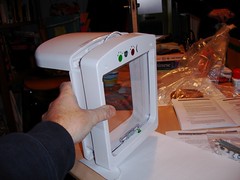

We were keen early adopters, since we have issues with neighbours' cats coming in and worrying the legitimate residents. Our two, Oscar and Felix, both 12. y.o., were often joined by The Black Cat from Two Doors Down. The happy group also included Zippy from Next Door as well, but she went through the cat flap in the clouds some time ago. TBCfTTD was a pain. He was young (2) and aggressive, and prone to spraying as well as being a chav.
We've tried magnet-sensing catflaps in the past, but they are a waste of time. Your furry friend has to haul a magnet collar around, which is detected by a coil in the sill of the catflap, which jinks open a solenoid and in he gets. All quite good, except that the magnets are quite large, and are lost. That is, removed by the cats, who just wanna be free. To have good time, to party.
So, when the opportunity to refit the doors came up, we decided to get the new door fitted with this miracle of RFID engineering. I'd heard about it after some speculative Googling, after a conversation about an undergraduate's technology/business dissertation. Handy sometimes, the day job.
A normal chip reader is hand-held if a bit clunky – I'm old enough to think Psion Organiser II when I see one – and in use it is waved across the neck of the animal to excite the chip and detect its response code (a moderately long integer). It's quite simple, and there's no encryption or anything. The manufacturers of the chips evidently collaborate to establish a system whereby all the codes are unique (otherwise what's the point?). The chips are used for positively identifying animals, which helps with lost doggy scenarios (chips are back-registered to the owner) and to discourage theft (though I've never seen an animal with a Don't Nick Me I'm Chipped sticker).
The flap-mounted chip reader is a bit clumsier than a hand-held reader. There needs to be a big detection coil with a nice spread-out field of action to catch the chip as it waves by at a random distance and speed, and this needs to be done before the cat, who can't read a manual, tries to get through the door. Consequently, there's a big bit sticking out of the outside of the catflap. Apart from that, the construction is much the same as other solenoid-locked catflaps, like the magnetic ones, slightly more chunky than a completely passive catflap.
We got ours direct from the manufacturers in Jersey. There's a lot that's clearly Version 1.o about the product. To me, it seems over-engineered in some places, and under-developed in others. It's also not that cheap. Do we really need to paw- and moon-shaped lights for example? A single LED could probably have sufficed. It may have been a requirement of the chip reader, but does it absolutely need a power supply? Other locking catflaps seem to make do with a 9 V battery.
Fitting is not different to any other catflap, with the added complication of ensuring that the Porch (the housing that contains the chip-reading antenna coil) is mounted and weatherproof.
With a cooperative cat, linking the reader to the chip is easy. If the cat doesn't have chip, there's a chip-free mode available.
Our cats were well used to catflaps, so this was barely any difference. There seems to be a slight delay before opening, but I think after a day or two most cats will adapt. I guess after a while they will listen for the click of the latch before really pushing.
- Features: good.
- Price: fair.
- Installation: slightly fiddly. Requires a constant power supply, i.e. uses 10 Watts and 1 socket.
- Other: antenna housing sticks out, this is a bit fragile and sticks out such that it may get struck by human legs and feet.
- Compatibility with cats behaviour: good (sometimes Oscar wants us to open doors, but that's probably normal).
- Keeps the Wrong Cats out: certainly.
Overall, a success.
No comments:
Post a Comment